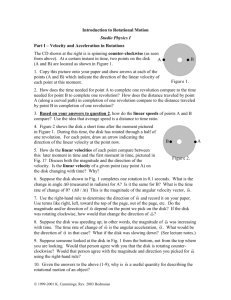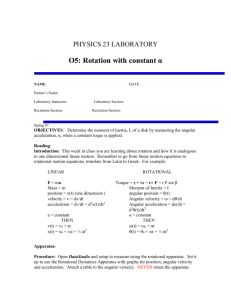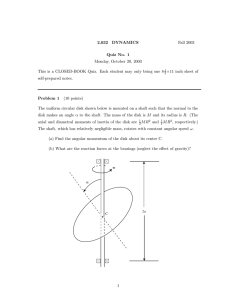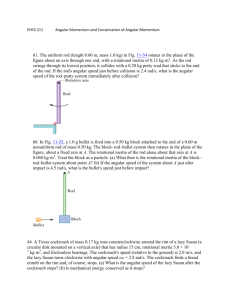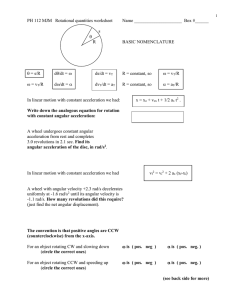Rotational Motion: Velocity, Acceleration & Inertia
advertisement
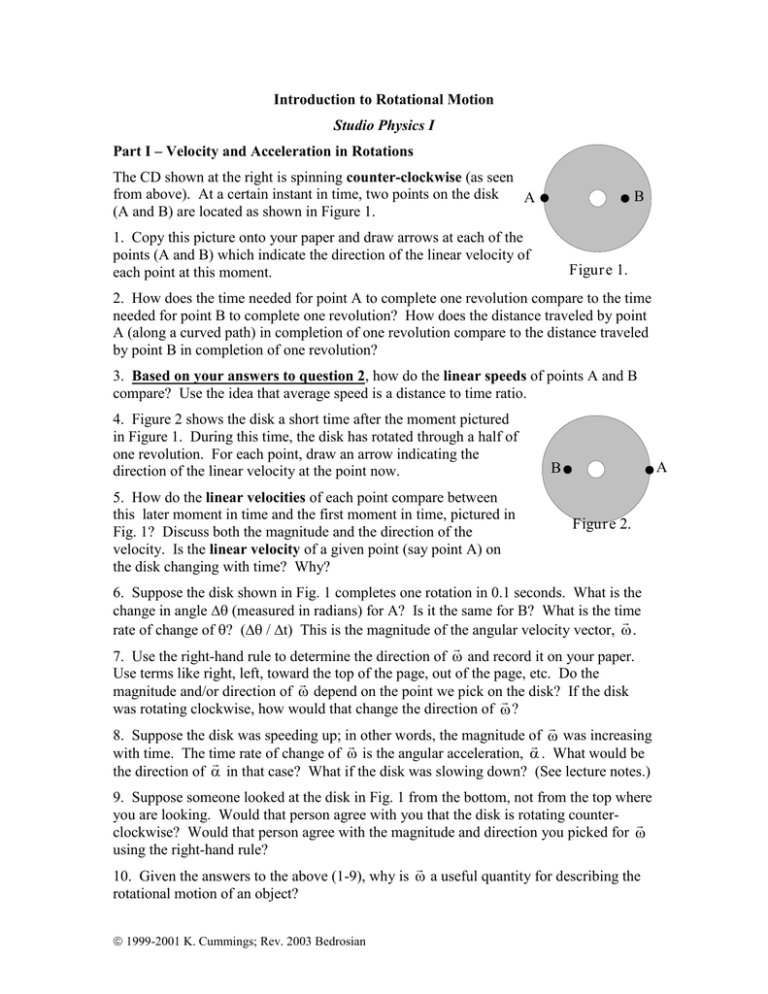
Introduction to Rotational Motion Studio Physics I Part I – Velocity and Acceleration in Rotations The CD shown at the right is spinning counter-clockwise (as seen from above). At a certain instant in time, two points on the disk A (A and B) are located as shown in Figure 1. B 1. Copy this picture onto your paper and draw arrows at each of the points (A and B) which indicate the direction of the linear velocity of each point at this moment. Figur e 1. 2. How does the time needed for point A to complete one revolution compare to the time needed for point B to complete one revolution? How does the distance traveled by point A (along a curved path) in completion of one revolution compare to the distance traveled by point B in completion of one revolution? 3. Based on your answers to question 2, how do the linear speeds of points A and B compare? Use the idea that average speed is a distance to time ratio. 4. Figure 2 shows the disk a short time after the moment pictured in Figure 1. During this time, the disk has rotated through a half of one revolution. For each point, draw an arrow indicating the direction of the linear velocity at the point now. 5. How do the linear velocities of each point compare between this later moment in time and the first moment in time, pictured in Fig. 1? Discuss both the magnitude and the direction of the velocity. Is the linear velocity of a given point (say point A) on the disk changing with time? Why? A B Figur e 2. 6. Suppose the disk shown in Fig. 1 completes one rotation in 0.1 seconds. What is the change in angle (measured in radians) for A? Is it the same for B? What is the time rate of change of ? ( / t) This is the magnitude of the angular velocity vector, . 7. Use the right-hand rule to determine the direction of and record it on your paper. Use terms like right, left, toward the top of the page, out of the page, etc. Do the magnitude and/or direction of depend on the point we pick on the disk? If the disk was rotating clockwise, how would that change the direction of ? 8. Suppose the disk was speeding up; in other words, the magnitude of was increasing with time. The time rate of change of is the angular acceleration, . What would be the direction of in that case? What if the disk was slowing down? (See lecture notes.) 9. Suppose someone looked at the disk in Fig. 1 from the bottom, not from the top where you are looking. Would that person agree with you that the disk is rotating counter clockwise? Would that person agree with the magnitude and direction you picked for using the right-hand rule? 10. Given the answers to the above (1-9), why is a useful quantity for describing the rotational motion of an object? 1999-2001 K. Cummings; Rev. 2003 Bedrosian Part II – Introduction to Rotational Inertia 11. Consider the system of two point particles shown. Each particle has a mass of 50 g and each is the same distance (12 cm) from the center point (which is marked with an X). There is a rod connecting the masses, but it is so light that it can be ignored. Calculate the object’s rotational inertia for a rotation about the center point. X 12. The locations of the point masses are now changed. They are pushed toward the center of the rod. See the diagram below. The masses are now each 2 cm from the center point. What is the object’s rotational inertia about the center point now? X 13. Start LoggerPro with the file “RotationalInertia.MBL”. You can get it from the course web page. Go to the activity listing and go to Activity 13, LoggerPro File A. You can also find this file on the Studio Physics CD in the Physics 1 folder. 14. Adjust the masses on the rod so that they are as close as possible to the center of the rod. Be sure to tighten the screws on the masses – if they come off, they can hurt someone. Click the Collect button in LoggerPro and give the end of the rod a firm push. Note the maximum angular speed and observe the time it takes for the spinning rod to slow down to half of its initial speed. (This is primarily due to bearing friction.) Divide the change in angular speed by time for an approximate value of angular acceleration. Repeat the measurement a total of three times and note the numbers in your write-up. Try to use the same force and same time (same impulse) of your push each time. Find the average angular acceleration (slowing down) for the three trials. 15. Now adjust the masses on the rod so that they are as close as possible to the ends of the rod. Again, be sure to tighten the screws. Click the Collect button in LoggerPro and give the end of the rod a firm push. Try to use the same impulse of your push as you did in step 14. Note the maximum angular speed and time to slow down to half that speed. Repeat a total of three times and calculate the approximate acceleration for each trial as the rod slows down. Find the average acceleration (slowing down) for the three trials. 16. Consider linear motion for the following question: Based on Newton’s Second Law and the Impulse-Momentum Theorem, if two objects at rest are given the same impulse from a push and friction is low, which object will have the higher speed after the push, the one with greater mass or the one with lower mass? (Hint: easy answer.) 17. For rotational motion, rotational inertia plays the same role as mass plays for linear motion. Is the maximum angular speed higher or lower in step 15 compared to step 14? Explain your answer using the concept of rotational inertia and the answer to 16 above. 18. In rotational motion, torque () plays the same role as force in linear motion. Assuming the friction torque in the bearings is approximately constant, and using = I (the rotational equivalent of F = m a), explain the difference between the average acceleration from 14 versus from 15 above. We will discuss the factors that relate a linear force to a torque in the next class. 1999-2001 K. Cummings; Rev. 2003 Bedrosian
